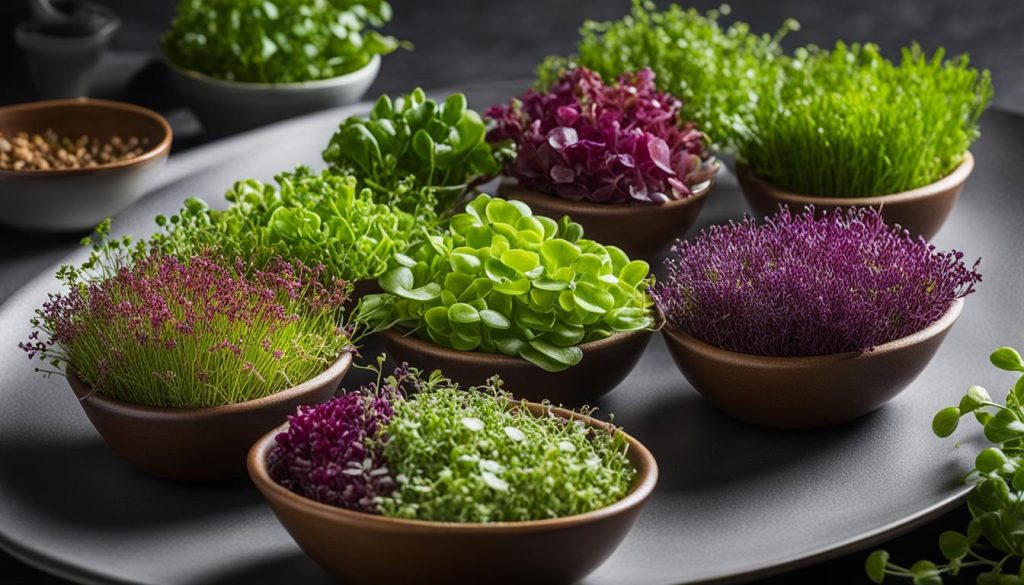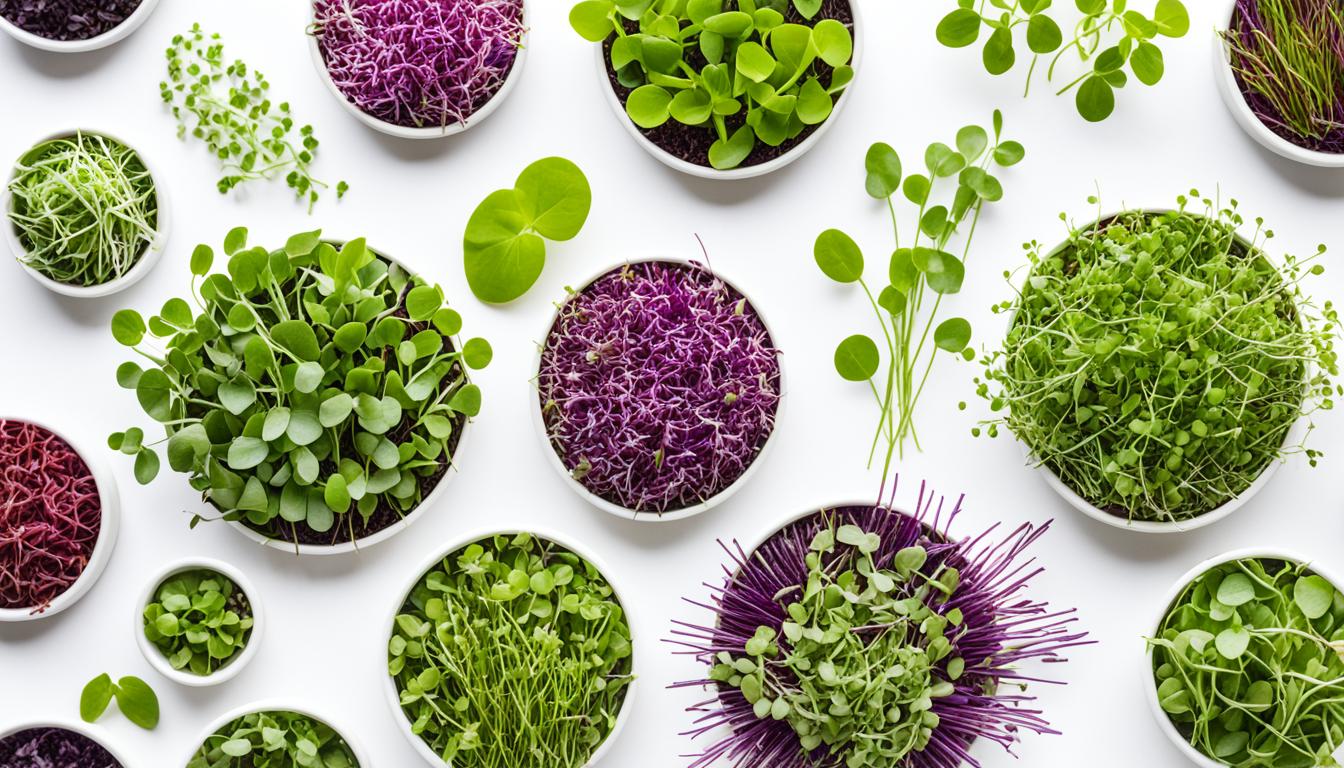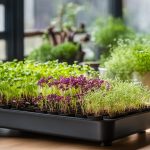The culinary landscape is bursting with vibrant, flavorful, and nutritious offerings, one of which is the ever-popular microgreens. These miniature greens are more than just a garnish; they’re a powerhouse of nutrition and flavor. In this fresh guide, we dive into the types of microgreens, their varieties, benefits, and tips for growing microgreens. Discover the big world of these tiny plants and how they can transform your diet and your kitchen.
Whether you are a seasoned chef seeking to add a pop of color and taste to your dishes, or a health-conscious individual aiming to enhance your meals with dense nutrients, microgreens offer a variety of options to cater to every preference. Stay tuned as we unravel the diverse selection of microgreens and how each brings its own unique zest to the table.
What Are Microgreens?
Microgreens are the seedlings of vegetables and herbs, harvested just after the first leaves have emerged. They are remarkably nutritious microgreens and are celebrated for their spectrum of flavors as well as their dense nutrient content. Unlike full-sized vegetables, these young greens are known for packing a more concentrated amount of vitamins and minerals, a quality that positions them as a staple in a health-conscious diet.
Understanding how to grow microgreens is a valuable skill for both gardeners and health enthusiasts. The simplicity of the process and the minimal space required make microgreens a perfect fit for indoor gardening. They can thrive in various mediums, including traditional soil or a soil substitute like coconut coir, harnessing the flexibility to grow in restricted spaces like urban apartments or small outdoor areas.
| Microgreen | Flavor Profile | Nutrient Highlights |
|---|---|---|
| Arugula | Peppery | Vitamin K, Calcium |
| Cilantro | Citrusy | Vitamin A, Potassium |
| Radish | Spicy | Vitamin C, Folate |
The personal touch of nurturing microgreens from seed to plate is not only rewarding but also supports a sustainable living approach. Plus, each variety, ranging from the spicy punch of radish microgreens to the lemony zest of cilantro, adds its own unique characteristic to enhance culinary dishes. Maintaining a rotating crop of diverse microgreens can transform your meals, imparting both complex flavors and a burst of nutrition.
Types of Microgreens
Microgreens have surged in popularity among health-conscious consumers and epicureans alike, offering a vibrant palette of flavors and a treasure trove of nutrition. From the peppery zest of arugula to the subtle sweetness of pea shoots, each variety of microgreen brings its own unique profile to the table. Let’s delve into the diverse world of microgreen varieties, exploring the best species for microgreen cultivation and the array of benefits they offer.
Brassica Family Varieties: From Broccoli to Radish
The Brassica family stands out in the realm of microgreens for its health-enhancing properties and includes powerhouse varieties such as broccoli, kale, and cauliflower. These microgreens flaunt short growth cycles and are popular for their pungent taste. Packed with glucosinolates, these nutritious microgreens can be a key component in cancer prevention diets and add a punch of flavor.
Amaranthaceae Family: Spinach, Beet, and Amaranth
The Amaranthaceae family is celebrated for its colorful and nutritionally dense microgreens, including spinach, beet greens, and amaranth. Known for their ease of growth and quick harvesting time, these microgreens not only present a burst of color on the plate but are incredibly beneficial for our health, being loaded with essential vitamins and minerals.
Fabaceae Family: Legumes as Nutritious Greens
Legume-based microgreens, like those from the Fabaceae family, provide an excellent source of protein and fiber. Varieties such as pea shoots and lentils are not only delightful in taste but they also play a vital role in regulating blood sugar levels and supporting heart health, serving as perfect additions to a heart-healthy diet.
Aromatic Herbs: Basil, Cilantro, and More
Aromatic herbs cultivated as microgreens, including basil and cilantro, offer intense flavors when picked young. These tender greens can spectacularly elevate a dish’s aroma and taste profile, making them ideal for garnishing and infusing a fresh punch to culinary creations.
Unique Flavors of Asian Greens: Mizuna and Tatsoi
Asian greens, such as Mizuna and Tatsoi, are treasured for their distinctive taste and are becoming increasingly popular in microgreen cultivation. They introduce a fusion of nutritional benefits and flavors that are both subtle and complex, suitable for a variety of dishes that aim to impress both visually and gastronomically.
Unlocking the Nutritional Power of Microgreens
The allure of microgreen cultivation extends far beyond their vibrant colors and fresh flavors. With the rise of health-conscious diets, the benefits of microgreens have garnered them the designation of a ‘superfood.’ These tiny greens are more than just a culinary trend; they are a concentrated source of essential nutrients, providing fibers, minerals, vitamins, and antioxidant compounds. Consumed in their raw form, they offer maximum nutrient retention, elevating everyday meals like salads, appetizers, and sandwiches with substantial nutritional value.
Given their nutrient-dense nature, microgreens are an excellent addition to a balanced diet. Their ease of growth at home also makes them an accessible way to boost nutrient intake. The table below captures the array of nutritional benefits attributed to various popular microgreens, showcasing why these small greens pack a big punch in terms of health.
| Microgreen | Vitamins | Minerals | Antioxidant Properties |
|---|---|---|---|
| Broccoli | Vitamin C, Vitamin K, Vitamin A | Calcium, Iron | Glucosinolates, Sulforaphane |
| Red Cabbage | Vitamin C, Vitamin K | Potassium | Anthocyanins |
| Radish | Vitamin E, Vitamin B6 | Phosphorus, Magnesium | Isothiocyanates |
| Pea Shoots | Vitamin C, Vitamin A | Iron, Potassium | Phenolic Compounds |
| Sunflower | Vitamin E, Folate | Magnesium, Calcium | Chlorogenic acid |
| Amaranth | Vitamin C, Riboflavin | Calcium, Magnesium | Peptides with antioxidant activity |
The readiness with which the health-savvy individual can cultivate these microgreens at home contributes to their growing popularity. Whether for those embarking on a journey to improve their eating habits or seasoned nutritional enthusiasts, integrating microgreens into the diet is an effective way to enhance health without compromising flavor or culinary enjoyment. Their bold nutritional profile is a testament to the enormous potential these miniature greens have in shaping a future where wellbeing and deliciousness go hand in hand.
Microgreen Cultivation: Sowing the Seeds of Health
The journey to a nutrient-rich plate begins with understanding the essentials of how to grow microgreens. These tiny powerhouses of health are not only a delight to the palate but also a visual treat for the eyes. With the right techniques in microgreen cultivation, even the smallest spaces in urban dwellings can turn into verdant garden nooks.
Choosing the Right Medium: Soil vs. Hydroponic
In the quest to reap the best harvest, selecting an appropriate growing medium is a fundamental step in growing microgreens. Let’s delve into the comparisons of soil and hydroponic systems—each with its own merits and considerations.
| Medium | Advantages | Considerations |
|---|---|---|
| Soil | Rich in nutrients, enhances flavor | Requires monitoring of moisture levels |
| Hydroponic | Space-efficient, uses less water | Nutrients must be added to the water |
Optimizing Growth: Light, Temperature, and Watering
Success in microgreen cultivation extends beyond the choice of medium. It involves creating the ideal environment where these greens can thrive. A dedication to maintaining the right light, temperature, and watering practices is key to nurturing your mini greens until they’re ready for microgreen harvesting techniques.
| Factor | Optimal Range | Tips |
|---|---|---|
| Light | 4-6 hours of sunlight or 12-16 hours under grow lights | Use LED or fluorescent grow lights for consistent exposure |
| Temperature | 18-24°C (64-75°F) | Maintain a stable environment, away from drafts |
| Watering | Keep evenly moist, not waterlogged | Water from below to prevent mold and evenly distribute moisture |
Whether you’re nurturing an assortment of flavors from radish to arugula or focusing on one variety at a time, the beauty of microgreen cultivation lies in its simplicity and the swift gratification it brings. With these insights, your path to a vibrant crop of microgreens is clear—begin your own green journey today and sow the seeds of health right in your home.
How to Grow Microgreens at Home
Joining the trend of growing microgreens at home is a fulfilling way to bring fresh, nutrient-packed greens directly to your table. Whether you’re perched in an urban apartment or have a sun-drenched suburban kitchen, how to grow microgreens is remarkably straightforward and does not require the complexities often associated with full-scale gardening. Below, we’ll dive into the essentials that empower you to start your own indoor microgreen garden using popular microgreens varieties.
To begin, choosing the right seeds is paramount. Opt for high-germination, non-treated seeds specifically meant for microgreen cultivation. These can range from the zesty flavors of radish to the delicate textures of pea shoots. Here is a table to guide you through the selection of popular microgreens:
| Microgreen Variety | Flavor Profile | Estimated Growth Time |
|---|---|---|
| Radish | Spicy, Peppery | 7-14 Days |
| Arugula | Nutty, Slightly Bitter | 5-7 Days |
| Pea Shoots | Sweet, Fresh | 8-14 Days |
| Sunflower | Nutty, Crunchy | 7-10 Days |
| Kale | Mild, Cabbage-Like | 8-12 Days |
After selecting your seeds, the setup is simple. You will need a shallow tray, quality potting mix, and a sunny spot or a grow light. Sow your seeds evenly across moistened soil and cover with a thin layer of soil or a damp paper towel. The magic starts to happen in just a couple of days, with sprouts beginning their journey upward.
Watering is crucial but over-watering is a common mistake. A misting bottle is your best friend here, allowing you to keep the soil damp without waterlogging your delicate greens. In 1-2 weeks, depending on the variety, your microgreens will be ready to harvest.
In the compact urban lifestyle, growing microgreens presents not just a hobby, but a step towards self-sustenance and nutritional enrichment. So why wait? Start cultivating your living salad bar right on the windowsill, and make the farm-to-table leap shorter than ever!
Best Microgreen Species for Beginners
Embarking on the journey of growing microgreens introduces you to a world of flavors and nutrients, especially for beginners looking for easy-to-grow microgreens varieties that don’t sacrifice taste. Certain best microgreen species are recognized for their straightforward cultivation process and delightfully distinct flavors which blend seamlessly into a variety of culinary dishes.
| Microgreen Variety | Flavor Profile | Growth Difficulty | Harvest Time |
|---|---|---|---|
| Radish | Peppery and crisp | Easy | 5-7 days |
| Lentils | Nutty and earthy | Easy | 7-10 days |
| Mustard | Spicy and tangy | Easy | 5-7 days |
| Kale | Mild and slightly sweet | Easy | 5-10 days |
Radishes, known for their vibrant colors and peppery kick, are a favorite among beginner gardeners. The combination of their visual appeal and prompt growth rate makes them a satisfying choice for newcomers. Lentils, on the other hand, offer a nutty flavor and are packed with protein, appealing to health-conscious growers. Mustard microgreens introduce a spicy heat to dishes and grow exceptionally quickly, allowing for rapid gratification of your gardening efforts. Lastly, kale microgreens provide a milder alternative to their mature counterparts, being both flavorful and nutrient-dense, making them a wholesome addition to any meal.
Each of these microgreens varieties caters to different palates and can elevate a simple dish to culinary artistry with minimal effort. They are a testament to the accessibility and joys of home gardening, providing a gateway into the enriching practice of growing your own food. For the beginner, these best microgreen species not only promise a bountiful and speedy harvest but also an enriching learning experience that sows the seeds for a long-term passion for horticulture.
Microgreen Harvesting Techniques
Gaining the full benefits of microgreens hinges not just on how they are grown, but also on how they are harvested and stored. Mastering microgreen harvesting techniques is crucial for gardeners aiming to savor these small greens at their peak freshness and nutritional value. The process calls for attention to detail and gentle handling to ensure these tender plants reach your plate full of vitality.
Harvesting microgreens is all about timing. The optimal period is typically between 7 to 14 days after sowing, when the first set of true leaves has developed. It’s a delicate procedure where each snip can influence the final quality. The preferred tools for the task are a pair of clean, sharp scissors or a knife which enable a clean cut just above the soil line. This method minimizes harm to the plant structure and reduces the risk of soil contamination.
Once harvested, the microgreens demand proper cleaning and storing practices to maximize shelf life and maintain their unique flavors. Rinsing them gently under cold water removes any soil and potential residue, priming them for storage. To store microgreens, climate control is key. They should be kept in an airtight container, preferably in the refrigerator, where a stable chill can significantly extend their freshness.
| Stage | Description | Harvesting Tools | Storage Tips |
|---|---|---|---|
| Pre-Harvest | Microgreens are ready when they exhibit their first set of true leaves. | Choose between sharp scissors or a knife. | Prepare a clean airtight container with damp paper towels. |
| Harvesting | Cut just above the soil to avoid soil contaminants. | Ensure tools are sanitized to prevent disease. | Rinse gently with cold water before storing. |
| Post-Harvest | Gather microgreens for immediate consumption or storage. | Handle with care to prevent bruising. | Dry thoroughly and place in the prepared container in the fridge. |
By adhering to these pivotal steps, you can enjoy your homegrown microgreens at their finest. Whether incorporated in a crisp salad or accentuating a gourmet dish, these greens, when harvested and stored properly, offer a quick and easy flavor and nutritional boost to any meal.
Culinary Creations: Using Microgreens in Recipes
The culinary uses of microgreens are as diverse as their colors, shapes, and flavors. With a vast array of microgreens available, food enthusiasts and chefs alike are constantly finding innovative ways to incorporate these delicate greens into their culinary creations. Whether you are looking to add a nutritional punch or aesthetic appeal, microgreens can elevate traditional dishes and inspire new recipes.
Integrating microgreens into salads is a straightforward approach that brings an intense flavor and a nutritional boost to every bite. When used in sandwiches, not only do microgreens add freshness, but they also introduce a variety of textures that interact pleasantly with other ingredients. For those who prefer a liquid approach to nutrition, microgreens blend seamlessly into smoothies, offering a subtle, yet impactful taste.
| Type of Microgreen | Flavor Profile | Best Used In |
|---|---|---|
| Arugula | Peppery | Salads, Pizzas, Sandwiches |
| Radish | Spicy | Salads, Tacos, Grain Bowls |
| Pea Shoots | Sweet, Fresh | Stir-fries, Salads, Wraps |
| Sunflower | Nutty | Smoothies, Sandwiches, Soups |
| Red Amaranth | Beety, Earthy | Garnishes, Egg Dishes, Soups |
The world of microgreens in recipes is only bounded by the limits of one’s creativity. From zesty taco toppings to elegant soup garnishes, microgreens span the full spectrum of culinary possibilities. With every use, they not only impart their characteristic tastes but also enhance the visual appeal of the dishes they grace, confirming their status as culinary gems.
Storing and Preserving Microgreen Freshness
Once you’ve harvested your vibrant microgreens, storing microgreens properly is essential to preserving microgreen freshness. Refrigeration is key, but to avoid the pitfalls of wilting or spoilage, a specific method must be employed. For longer-lasting freshness, create a micro-climate within your storage container that mimics their ideal living conditions.
Here is a simple guide to ensure your greens stay as fresh as the day they were picked:
| Step | Instructions | Tips |
|---|---|---|
| 1. Harvest | Use clean scissors to cut the microgreens. | Avoid crushing the stems to prevent damage. |
| 2. Dry | Gently pat the microgreens dry with a paper towel. | Excess moisture can encourage bacterial growth. |
| 3. Prepare Storage | Line a container with a damp paper towel. | This keeps humidity levels optimal without soaking the greens. |
| 4. Place Greens | Spread the microgreens in a single layer over the towel. | Prevents compression and ensures even airflow. |
| 5. Seal and Store | Cover with another damp paper towel and seal the container. | An airtight container is crucial to retaining freshness. |
| 6. Refrigerate | Store the container in the crisper drawer of your refrigerator. | A consistent temperature is maintained in the crisper drawer. |
By following these steps, your microgreens can stay fresh for up to a week, sometimes even longer, depending on the variety. Remember, delicate handling and maintaining a balanced moisture level are the cornerstones of extended shelf life for these nutrient-packed greens.
Benefits of Microgreens Beyond the Kitchen

Often celebrated for their culinary versatility, microgreens offer an array of benefits transcending mere flavor enhancements. As tiny as they are, these nutritious microgreens are giants in the realm of health promotion, contributing significantly to our wellness with every colorful sprinkle on a dish. The innate density of vitamins and antioxidants in microgreens position them as vigilant protectors against a myriad of chronic diseases, fostering an environment within our bodies that thrives on prevention and vitality.
| Microgreen | Key Nutrients | Health Benefits |
|---|---|---|
| Broccoli | Vitamins A, C, and K, Calcium, Iron | Supports immune system, bone health, and antioxidant protection |
| Kale | Vitamins K, C, and E, Antioxidants | Enhances eye health, anti-inflammatory effects, skin vitality |
| Pea Shoots | Vitamins A, C, and Folate, Iron | Promotes healthy blood cells, energy metabolism, growth and repair |
| Radish | Vitamins E, B6, and B9, Antioxidants | Aids in detoxification, regulates blood pressure, supports digestion |
| Sunflower | Vitamin E, Selenium, Magnesium | Improves heart health, muscle function, and mental well-being |
Equipped with these potent nutrients, microgreens not only offer a boost in flavor but also infuse our meals with a meticulous blend designed for our body’s multifaceted needs. They are a testament to the idea that great things come in small packages, delivering a powerful punch of health in every tender leaf. Incorporating microgreens into our diets is an effortless, yet effective strategy for enhancing not just our food, but our overall quality of life.
Conclusion
The journey from seed to garnish with microgreens is one of simplicity yet abundant reward. Harnessing the benefits of microgreens through growing microgreens can be seamlessly achieved in the comfort of one’s residence, no matter the size constraints. Their diminutive stature belies a remarkable density of nutrients, making them a stalwart ally for health-conscious individuals and culinary enthusiasts alike.
Microgreen cultivation is a testament to sustainable practices within our reach, enabling urban dwellers and others with limited outdoor space to participate in the green revolution from their very kitchens. The freshness and vibrant kick that these greens add to a meal is matched by the satisfaction of cultivating your own food source. Plus, storing microgreens with the correct techniques ensures an extended enjoyment of their freshness and a steadfast presence in your dietary routine.
Adopting microgreens into your daily diet represents a minor change with substantial effects. Enhancing meals with both nuanced flavors and a powerhouse of vitamins and minerals, these petite plants serve as a continuous reminder of how mindful choices in our eating habits can lead to substantial improvements in our overall well-being. They punctuate the notion that great things indeed come in small packages.


